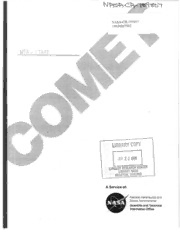Table Of ContentASA-CR-189807
19920007982
LIBRARY COpy
23~
LANGLEY RESEARCH CENTER
LIBRARY NASA
HAMPTO ,VIRGINIA
A Service of:
National Aeronautics and
Space Administration
ScientificandTechnical
Information Office
1IIIIIIIIIIIIIIIIifli~l~ilrflljrlil'l~irfmllllllllllllIIII
.'I
Jell'PJoJtl
.' 1
,,}_~~~~01420 1256
:'L 'i- ---_.._n___. GR"Nr
..,
.....:. I
/11 •
-/8 - clf...//
J
G'I3 tP () I
f~ ~\
FINALREPORT
I
,".
submiuedto I
I
NationalAeronauticsandSpaceAdministration
LyndonB.JohnsonSpaceCenter
I
S~ScienceBranch
ATI'N:EricL.Christiansen
Houston,TX770S8
I
I
forresearchentidcd
I
HYPERVELOCITY IMPACT SIMULATION FOR MICROMETEORITE
I
AND DEBRIS SHIELD DESIGN
I
Submittedby
I
I
. EricP.Fahrenthold
DepartmentofMechanicalEngineering
UniversityofTexas
Austin,TX78712
January27.1992
I~PACT
(NASA-CR-189807) HYPERYELuCITY N9Z-17Z00
SIMULATION FOR MICROMETFO~ITE AND OEBRIS
SHIELD DESI~N'final Report (TexdS Univ.)
81 p CSCL 2ZB Unclas
G3/18 0064300 I
~"..<C'.'=.;"'''''_
..
..
,"~ "-~, ~
_. .... ,.,.. - -• .:_...??,
. , ,""""-.",. - - - -, Wi .__.
Hl
-.
I i
..1
1
i ....
I I
I
I
1
·\
·
FINALREPORT '
j
\.
·
,
·
;
i
~
NaIiaaalAaoaoti§aDdSp:eAdmiDisIradon
LyndoaB.JohnsonSp:eCenter
S.-:eScienceBranch .
ATI'N:EricL ClrildaDsen
Houstoli,TX77058
HYPERVELOCITY IMPACf SIMULATION FOR MICROMETEORITE
AND DEBRIS SHIELD DESlGt4
Submittedby
,
j
EricP.Fahren1hold
/
DepaI1JDeatofMecbaJUcalEngineerin
I
-I UniversityofTexas g
Austin,TX78712
Jmuary27 1992
t
.........
-.-
L
ri:
-'
-----_._~.,_...".. .. I. !
\ j iJ
A new capability bu bccD dcftloped for direct computer simulation of \
\
hype1'Ye1ocityimpIc1sonmulti-plateorbiIIldebrillbieJds.forcombmatiol.~ ofloW/~hieJd \I 1,
~ !:'j
dUclmessIDClwideshieldspeciDcwhichpIIceeaueu:edemandsonCOI1WIlticaalBaJedaD ,"\
lIII1ysis techniques.ThemocIeIinlmedIadolOl)'lepieaeal1sanovelappmIdatodeIlris
-.
,.'
cloud dynamics simulation. aproblemof loa,lInD intelat in 1he desip of spICe
I;
SII'UCbIIeS.SoftwareimpJementadoDofdieIIIOdeUnamedJodoIoayprovidesaDeWdaip
toolforenaineerinllDl1ysis~pmpoIedaditaIdeIIdIproIeClionsys1aIlS.
./
..
i
j
ii
I
l~:::..:-.-:..::. ~~.," .~ ..i-.'"..:._~~~""""~~J'·:££,~,;;Kii.l1¥a!;i~·;"'~·~d'ii:;;;;;;:==::::::::::.~::~al'J ~
__" ,
..
_/
'·"'1
I [
j
t
1
.-1
ACKNOWLEDGEMENTS ;
[
ThisworkwufundedUDdertheNASARepoaalUnmnitiesGrantPqram.'lbe r
[
assistanceofEricL.Qristi,nseo(NASATecIuUcalOfficer)_leanneLeeCrewsofdie
SpaceScienceBranchoflo1mso1lSpaceCenterbasbeenIIUt1Yappreciated.Addidoaal
supportwu provided by Cray ReseaIc'h. Inc. UDderthe Cray UniversityResearch_
DevelopmentGrantPropamandbytheTexasHigherEdDcadonCoordiDatinIBomlUDder
theEncqyResearchinApplicationsPqram.ComputerdillewuprovidedbytheCenter
for Hip Performance Computinl and the Institute for Advanced TeebnotoBY at the
UniversityofTexasatAustin.
iii
,~-~--
---'._-.
-.--,---_.
SOFrWAIIE COPYRIGHT NonCE
SomcecodedeYeJopeclaaderdIiIft*I1dlpmjectbabceDpiovidcd10NASA.
OtherincaellellpmiesIhouJdDOlethatIbissoftwIIe..becacopydahted(1991)bythe
~imad....ufollows:
(1)SoftwaewriaeD10JiDkthec:odeIClHIDdDYNA2DbubeeD~u
an«WipalWOIkUDderIbeddeDC1'2D(DeIIdIQoad1ftnsI...2-DimeaDxW).
(2)SoftwarewriamCDInpmttheItIIIdInlDYNA2Dcodebasbeen~
u aderivativeworkUDderdietideDCA2D(DellisCloudAupaematica2-Dimendoaal).
i
.J
,
!
~..' iv
'.
TABLE.OF CONTENTS
Paac
1
Introduction
2
S
Multi-plgSbjeId1"111"3Sjrnnlarim
"~.'.
8
CgncIusian
9
References
Iab1Gl
10
Table1.Simulationparameters:mulli-p1aleshieldimpact
fipres
11
Ftpre1.EuleriansimulationandleZlDDCpmc::eduIe
12
Filure2.Lagrangiansimulationandrezoaeprocedure
13
Figure3.Multi-platesbicJdimpactproblem
AmrD'm
A-I
AppendixA-ExampleplateimpactsinmJarioo.
B-1
AppendixB-MulIi-p1alesbieJd:fiIstpJa1eimpact
c- C-1
Appendix Multi-plateshield:secondp1aleimpact
0.1
AppendixD-Multi-p1alesbidd:1birclplateimpact
E-1
AppeIIdixE-Multi-plateshield:fourthp1aleimpact
F-t
AppendixF-Multi-plateshield:wallimpact
- ~..-------
v
,
\ .
Introdudlon
Thisreportdescribes the result3ofcodedevelopment work andsupercomputer
basedhydrocodesimulationsconducledtopursuecomputeraideddesipofspacedebris
shielding(Cour-PalaisandCrews, 1990andCuisdaasen, 1990).
PmiousprogressrepodS (Fahrenthold, 1990aandb,aad1991.)havediscussed•
.numw-'of hypervdocity impact simulations conducted using the Sandia·National
.
(
Laboratodeshydrocodes CSQ(1bompSOD, 1990&)andem(McGlaunet11., 1990),to
evaluaae1beirutilityinmodelingimpactsonmulti-platedebrisshields.Theresultsofthat
wen
worksugaredthatexistingEuleriancodesarenot suitedforuseinctirectcomputer
simulationofimpactsonmulti-platedebrisshields.RecopizingtheUmitatioDsofavailable
. Eulerian codes, the last progress report (Fahrenthold, 1991b) describedan alternative
appuJ8Chtosimulationoftheproblemofinterest.'IbisapproachcombinedEulerian(CIH)
modelingoftheshieldperfomionprocesswithanewLagrangianmodelofdebriscloud
evolution.TheLagrangiandebriscloudmodelwasdevelopedusinganaugmentedversion
ofthe finile elementcode DYNA2D (Hallquist, 1987).The basic DYNA2D code was
developedItLawrenceLivelmore National Labora1ories.TheDYNA2Daugmentation,
developedaadcodedbytheprincipalinvestigatorforuseinthepresentresearchproject,
tookthefmnofamixturetheorybased(Dmmheller, 1987,andDrumhellerandBedford,
1980)cqUlliOllofstate·fora solidmaterialcontainingvoids. Additionalpre-processing.
post-processing,fAdrezoningroutinesusedtosystematicallylinktheCIHandDYNA2D·
simulationswere alsodevelopedandcodedby theprincipalinvestigator.Theresultis a
DeWcompUliersimulationcapabilityf(ll"multi-platedebrisshieldimpacts.
Thepresentreportoutlinestheanalysisprocedureanddescribesanexamplemulti
platedebrisshieldimpactsimulation.Tablesandfiguresmeincludedafterthemainbodyof
thereport,whilethecomputergraphicsdepictiagtheimpactsimulationsareprovidedas
appendices.Suggestionsforfutureworkarediscussedintheconclusionssection.
1
_
-----------
~_~ A·_ ......-"-,.••• •
Anal"
procedure !-.
Theanalysispnxedureis~IedbytheflowchutsshowninFipra 1and2-
Aspresentlyform~ abeprocechRmodeJstwo-dimcasioDal(axisymmetric)impactof
liteI1l81erials.Mas~ kineticenergy.voidvolume.anddensityateeonsavalinBulerian
to-LagranpmorLapangian-to-Bulerilntnlnslllioasofdebrisclouddata.TbenoalenertD'
i
is discarded. OeneralizatioD of thU lDalysis procedure is possible. given additional
L
developmentwork. SimuJaUOD ofthe DOI'IDI1impIctofahypervelocityprojectileon a
f
mu11i-pla1edebrisshieldprocccd.sasfoDows:
(1)ImpactofmeprojectileonmefloatshieldplateismodeledusingmeEulerian
codeCTH(Fig1D"e 1).Geometry.materialproperties.inid.alvelocities.andoilierinputdata
me
arespecifiedintheinput deeth.TheoulpUtfile(neth)fromtheClHsimulationisthen
J :
inputtomepost-processorCTHED.Usingthispost-processor.meuserselectstheregion
of space contaiDingthedebris whichmustbepropapted. to the next shield.Themass.
velocity. and.pressuredistribution in thedebriscloudiscontainedin thepost-processor
outputfiledcoUl.
(Z) Next (Picure 1) the routines delink!anddeg2a!are used to generate a
Lagrangian model ofthe debris cloud(dcdyna). given the Bulerian simulation results
Cdcout) and the geometry. material. and conuol datacontainedin the user input files
'-.,
"-
dcg2dinpanddebase.
(3) The file dcdyna is inpUt to an augmented version of the Lagrangian code
~
DYNA2D(Figure2).whichincorporataamixtureequationofstatefora with
i
voids.aswellasa~dSl*eevolutionequation.Theauxiliaryinputfilervl2d.dDt~
by dcg2dlis required to properly initialize the DYNA2D ca1cu1ation.A Lagnmgiar..
simulationisthenusedtopropagatethedebristothenextshield.Anau:xinaryoutputfile
dcru.datiscreatedforuseininitialliingmenextEulerianshichiimpactcalculation.
(4) Finally the results ofthe Lagrangian.simulation «(Jerez.dat) arc inputto the
routinedcrez!(Figure2).todevelopanEuleriandescriptionofthedebriscloudimpacting
2
L
I
\.,
the next shield. The routine dcr6z1 also lequires as input certain pometry, mesh
connectivity, andmassdistributiondatacontainedin the files dcrez.iIIp,T'll2d.dat, and
dq2d.out, thelattertwohavingbeenpreviouslypnerateclbydcg2df. Theoutputfrom
dcraf,containCdinthefiledcrez.OIlt,iscombineddirectlywithuscr-specifiecIpometty,
material,andCOIluoldata(dceth.l anddeeth.2)describingthenextshieJd(orwall)impact
calculationtobeperfcrmeeL,TheresultingC'lHinputfile(dcctJa)isusedtoiDitiIIearepeat
cycleofcalculadoo5,startingroltheafcftmentionedstep(1).
(5)Insomecases,oneorIIlCRrezonesoftheLagrangianmeshmaybeRqUireclto
propagatethedebrisbetweentwoadjacentshields.Inthiscase(Pigure2),thefiledeethis
created as in step (4), butwithoutanew shield model, andthen inputto theC11Ipre
processorCl'HGEN.Theresultingoutputfile(neth)isthenpost-processedusingCI'HED
andarezonedLagrangianmodeliscreatedasinstep(2).ThisLagrangianrezoneprocedure
is well suited to mixture theory baseddebrismodels, although aspecial (dmct)rezone
routinecouldbewriuenforthispurpose.NotethatthestandatdDYNA2Drezonercannot
beusedinthiscase,duetothepresenceofvoidspaceintheLagrangianfiniteelements.In
anycase,conventionalLagrangianrezon~ proceduresateill-suitedtothisapplication,due
totheextremelycomplexgeometryofthedebrisclouds.
Althoughtheoutlinedanalysisprocedureappearscomplex,itshouldbeemphasized
thattheEulerian-to-L8grangian'andLagrangian-to-Euleriantranslationshavebeenhighly
automatedby the routines dclinlcf,deg2df, anddcrez/. Onlytwoveryshortinputfiles
(dcg2d.inp and dcrez.inp) beyond those normally required in performing C11I and
users
DYNA2Dcalculalionshavebeenaddedtothe datapreparationwoddoad,sincethe
remainingauxiliaryinputfilesarecreatedautomaticallybytheinterfaceroutines.Despite
thisfact, multi-plate impact simulations are generally userandCPU time intensive, as
dem>nstratedbytheseriesofsimulationsdiscussedinthenextsection.
Toillustratetheanalysisprocedure,considertherepresentativeproblemofa0.32
emdiameter aluminum sphere impacting upon a 0.081 em thick aluminum plate at a
3
---...--..--." ..··----·.. 1~

